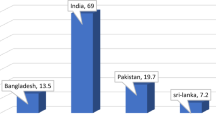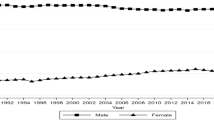Abstract
Fluctuations in unemployment rate have been widely studied in developed countries. Lack of panel data, however, limited the scope of such studies in India until quarterly periodic labour force surveys (PLFS) were published in 2019. Here we use the novel quarterly PLFS of urban sector in India to study the gross flows using three states of labour market. We found most of the fluctuations in unemployment rates originates within the labour force. In upturn, employment margin contributes about 80% of the decline in unemployment, while in downturn it contributes about 98% of the rise in unemployment. Flows from employment to unemployment have stronger association with the fluctuations in unemployment rate than the flows from unemployment to employment. Higher female unemployment rates are mainly because of their lower chances to find job and higher chances to stay as unemployed. Contrary to widely held view, we found females are more likely to participate than males. Their higher probability to drop out of labour force and lower chances to find a job hold their labour force participation rate low. Youth face higher chances to lose jobs and their longer stay as unemployed than mature hold their unemployment rates higher. Difficulty in finding a job, higher chances of job loss, along with longer stay as unemployed keep unemployment rate higher among the better educated.

























Similar content being viewed by others
Notes
The quarter 5 reflects in revisit file of the personal data for survey year 2017–2018 as well as in the first visit and revisit file for survey year 2018–2019. Therefore, instead of including quarter 5 from 2017 to 2018, we have taken it from survey year 2018–2019. Abdul-Razak and Sahoo (2021) mention it as a problem of misspecification of the quarter number.
For transition from unemployed or from ‘not in labour force’ occupation and industries cannot be defined.
Flows either from employed to unemployed (EU), unemployed to employed (UE), unemployed to inactivity (UN) or inactivity to unemployed (NU).
Net inflow in unemployment (EU − UE) at employment margin as a percent of net change in unemployment [(EU − UE) + (NU − UN)] in a quarter.
Shimer (2005) shows that the flow from employment to out of the labour force is not cyclical, though it has subcyclical trends.
Shimer (2005), job-to-job transitions fell during the one observed recession, in 2001.
References
Abdul-Razak, Shihas and Soham Sahoo. 2021. Using the Rotational Panel Data from the Periodic Labour Force Survey: A Cautionary Tale, (September 28, 2021). Available at SSRN: https://ssrn.com/abstract=3932499.
Abowd, John M., and Arnold Zellner. 1985. Estimating Gross Labor-Force Flows. Journal of Business & Economic Statistics 3(3): 254–283.
Albanesi, S., & Şahin, A. 2018. The gender unemployment gap. Review of Economic Dynamics 30: 47–67.
Bhattacharya, Jyotirmoy. 2021. Indian Urban Workers’ Labour Market Transitions, arXiv:2110.05482. https://doi.org/10.48550/arXiv.2110.05482.
Blanchard, Olivier, and Peter Diamond. 1990. The Cyclical Behavior of the Gross Flows of U.S Workers. Brookings Papers on Economic Activity 2: 85–143.
Clark, Kim B. and Lawrence H. Summers. 1978. Labor Force Transitions and Unemployment, NBER Working Papers 0277, National Bureau of Economic Research, Inc.
Darby, Michael R., John Haltiwanger, and Mark Plant. 1985. Unemployment Rate Dynamics and Persistent Unemployment Under Rational Expectations. American Economic Review 75(4): 614–637.
Darby, Michael R., John Haltiwanger, and Mark Plant. 1986. The Ins and Outs of Unemployment: The Ins Win. NBER Working Paper No. 1997.
Davis, S.J., and J. Haltiwanger. 1992. Gross Job Creation, Gross Job Destruction, and Employment Reallocation. Quarterly Journal of Economics 107(3): 818–86.
Deshpande, Ashwini and Jitendra Singh. 2021. Dropping Out, Being Pushed Out or Can’t Get In? Decoding Declining Labour Force Participation of Indian Women, Ashoka University.
Ferraro, Domenico. 2013. The Asymmetric Cyclical Behavior of the U.S. Labor Market. Durham, NC: Department of Economics, Duke University.
Fujita, Shigeru and Garey Ramey. 2007. Reassessing the Shimer Facts, Federal Reserve Bank of Philadelphia Working Paper 07-2.
Hall, R.E. 2005. Employment Efficiency and Sticky Wages: Evidence from Flows in the Labor Market. Review of Economics and Statistics 87(3): 397–407.
Hall, R.E., Gordon, A. and Holt, C., 1972. Turnover in the labor force. Brookings Papers on Economic Activity 1972(3): 709–764. http://web.stanford.edu/~rehall/Turnover-BPEA-1972.pdf
Kandoussi, Malak and François Langot. 2020. The Lockdown Impact on Unemployment for Heterogeneous Workers, IZA Discussion Papers 13439, Institute of Labor Economics (IZA).
Kniesner, Thomas J., and James P. Ziliak. 1996. The Importance of Sample Attrition in Life Cycle Labor Supply Estimation. Economics Faculty Scholarship. 121: 66.
Mortensen, Dale, and Christopher Pissarides. 1994. Job Creation and Job Destruction in the Theory of Unemployment. Review of Economic Studies 61(3): 397.
Mueller, A.I. 2012. Separations, Sorting and Cyclical Unemployment, IZA Discussion Papers, No. 6849
Neog, Bhaskar. 2020. Job Reallocation Dynamics in India: Evidence from Large Manufacturing Plants. Oxford Bulletin of Economics and Statistics 82(4): 934–959.
Perry, G.L., Hall, R.E., Holt, C. and Kaitz, H., 1972. Unemployment flows in the US labor market. Brookings Papers on Economic Activity 1972(2): 245–292. https://www.brookings.edu/wpcontent/uploads/1972/06/1972b_bpea_perry_hall_holt_kaitz.pdf
Samaniego, B. and C. Viegelahn. 2021. Estimating Labour Market Transitions from Labour Force Surveys. The Case of Viet Na, ILO Working Paper 35.
Shimer, R. 2005. The cyclical behavior of equilibrium unemployment and vacancies. American economic review 95(1): 25–49. https://www.aeaweb.org/articles?id=10.1257/0002828053828572
Shimmer, R. 1998. Why Is the U.S. Unemployment Rate so Much Lower? NBER Macroeconomics Annual 13: 11–6.
Funding
No funding was used for the paper.
Author information
Authors and Affiliations
Corresponding author
Ethics declarations
Conflict of interest
No explicit conflict of interest. Please add disclaimer, “Views expressed are personal”, as a part of the paper if published.
Additional information
Publisher's Note
Springer Nature remains neutral with regard to jurisdictional claims in published maps and institutional affiliations.
Rights and permissions
Springer Nature or its licensor (e.g. a society or other partner) holds exclusive rights to this article under a publishing agreement with the author(s) or other rightsholder(s); author self-archiving of the accepted manuscript version of this article is solely governed by the terms of such publishing agreement and applicable law.
About this article
Cite this article
Singh, J. Unemployment Fluctuations in Urban Labour Market in India. Ind. J. Labour Econ. 66, 81–111 (2023). https://doi.org/10.1007/s41027-022-00417-2
Accepted:
Published:
Issue Date:
DOI: https://doi.org/10.1007/s41027-022-00417-2




